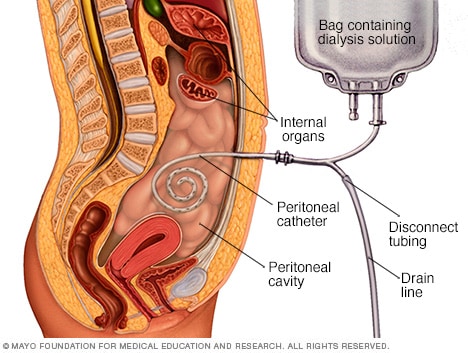Kidney Failure: Your Treatment Options
What is Chronic Kidney Disease?
Kidney disease is a serious chronic condition in which the kidneys begin to shut down and not function properly ultimately ending in renal failure. Like other chronic diseases such as heart disease, diabetes, etc., the descent into kidney failure is largely unnoticed in the patient and is not often detected early by medical professionals. Unlike heart disease, there is less funding and public knowledge about kidney health. There are many different causes for kidney disease such as history of diabetes, high blood pressure, genetic predisposition, infection, and many more. Each story is unique to the individual. Kidney disease effects approximately 31 million persons in the US per the American Kidney Fund (2015). Many of those effected with go on to have kidney failure but discussion and research on treatment options should be done early on by the nephrologist and the patient. See below for a video with a great overview on treatment options.
No Action
This is the less discussed and most difficult option to discuss among for medical providers and patients alike because this course of action means that the disease will be allowed to take its course and the end result for the patient will be death. This does not mean that no care will be provided. The patient who chooses this option will continue with their life as it is until they become symptomatic with the disease progression. Once they start to experience the effects of their renal failure, the healthcare team will work with the patient to help provide comfort measures
Transplant
Transplant is the by far the option that most people are aware of and provides that patient with the best results if the transplant is successful. There are two types of transplant options; living donors and deceased donors. Living donors are when a friend, relative, or even stranger donates their kidney for transplantation. The benefits to these transplants are shorter recovery times, planned transplantation, better organ function, and a shorter transplant process (Transplant).
Deceased donors are those who have passed away and decided to donate their organs to those who need them. This is the most common route by which to receive an organ transplantation. The recipient will be placed on a transplant list once approved by a transplant team and the average wait time is 5 to 7 years for a kidney. Many will have to undergo dialysis while waiting for their transplant.

Dialysis is when the patient undergoes chemical and fluid exchanges either through their blood stream of the lining of their abdomen, or peritoneum, which replaces their kidney function by use of an artificial kidney. Dialysis replaces about 15% of the kidneys normal function (DaVita). There are two types of dialysis available
Hemodialysis
Hemodialysis, pictured above, is the process of undergoing exchanges via the blood stream by either a vascular access or central venous catheter. The patient is connected to the machine via blood lines and passes the blood through the artificial kidney cleaning the toxins and excess water from the body over the course of a few hours (Hemodialysis). This is either done in an outpatient dialysis unit three times per week or more frequently at home by the patient and their support system. With the vascular access that is placed by a surgeon, needles are inserted to access the blood. In center dialysis is the preferred method of dialysis in the United States. At home provides the most flexibility for the patient as far as scheduling and being able to do it in the comfort of one’s own home. Hemodialysis also requires the patient to adhere to a strict renal diet often in combination with other diets like heart or diabetic depending on the patients co morbidities.
Peritoneal Dialysis
Peritoneal dialysis is a mode of dialysis that is done at home by the patient and their support system typically overnight. A catheter is inserted into the lining of the abdomen called the peritoneum, and that catheter is used for the exchange of the dialysate fluid that conducts the dialysis process. When done overnight, there are as many as four or more exchanges being made after hooking up to the catheter. Peritoneal dialysis provides the greatest freedom for the patient as it is done while they are sleeping, has the least restricted diet, and is also the gentlest on the body as is slowly exchanges the fluid and toxins over a longer period of time and blood is not drawn from the body to conduct the dialysis.

There are many different options of how to treat your Renal Failure. Deciding which mode of treatment is right for you is purely personal as only you know what fits best in your life. Be sure to have an open discussion with your nephrologist about all treatment options to decide which fits your lifestyle the best.
References
2015 Kidney Disease Statistics [Statistics]. (n.d.). Http://www.kidneyfund.org/assets/pdf/kidney-disease-statistics.pdf.
Dialysis linked to dementia in seniors [Digital image]. (2018, September 4). Retrieved May 8, 2019, from https://www.health24.com/Medical/Dementia/News/dialysis-linked-to-dementia-in-seniors-20180815
Hemodialysis. (2018, January 01). Retrieved May 8, 2019, from https://www.niddk.nih.gov/health-information/kidney-disease/kidney-failure/hemodialysis
Peritoneal dialysis [Digital image]. (n.d.). Retrieved May 8, 2019, from https://www.davita.com/treatment-services/dialysis/what-dialysis-can-and-cannot-do
Transplant. (n.d.). Retrieved May 8, 2019, from https://www.barnesjewish.org/Medical-Services/Transplant/Kidney-Transplant/Kidney-Transplant-Options
What dialysis can and cannot do. (n.d.). Retrieved May 8, 2019, from https://www.davita.com/treatment-services/dialysis/what-dialysis-can-and-cannot-do
